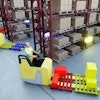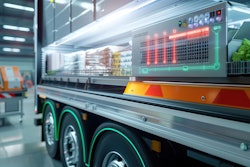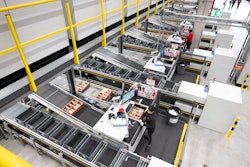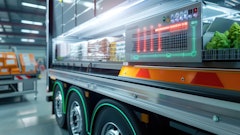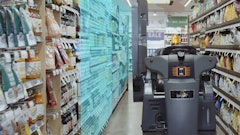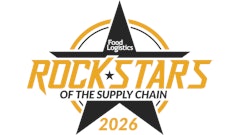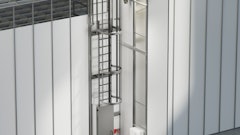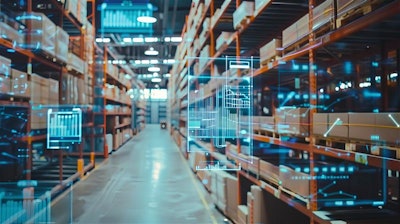
The future of warehouse automation involves emerging technologies, everything from artificial intelligence (AI) and cobots to predictive maintenance, robotics, augmented reality (AR), machine learning (ML) and more.
Present day, these automated systems are revolutionizing the way warehouses operate, driving efficiency, improving accuracy, reducing labor costs, increasing safety and more.
Food Logistics sat down exclusively with Keith Moore, CEO, AutoScheduler.AI to discuss FSMA 204, warehouse management systems and why the warehouse still needs human employees.
CLICK HERE to read Part 1 of this article in full. CLICK HERE to read Part 2 of this article in full. CLICK HERE to read Part 3 of this article in full.
Food Logistics: The future of warehouse automation involves emerging technologies, everything from AI and cobots to predictive maintenance and more. What are some of the key technologies and solutions every company in the cold food chain space must employ in order to future-proof their supply chains?
Keith Moore: When supply chain managers want to improve efficiencies within their warehouses, they often just throw automation into the mix, from automated guided vehicles (AGVs) that transport goods within the warehouse to robotic arms that pick and pack items. But equipment is only as fast as the humans that run it or must work alongside it.
The integration of robotics amplifies the need for meticulous planning and scheduling. While robots are efficient, they operate based on predefined algorithms and lack the intuitive decision-making ability of humans. If a robot encounters an unexpected obstacle or a change in its routine, it requires a set of instructions on how to proceed. These unexpected scenarios can lead to significant downtimes without a robust planning system.
Workers are often required to work alongside robots, ensuring they function correctly, intervening in malfunctions, and providing the human touch where robots fall short. This human-robot collaboration introduces another layer of planning complexity, as schedules must be coordinated between man and machine.
Warehouse automation requires a robust planning and scheduling system like AutoScheduler that works alongside a WMS, YMS, or ERP to optimize workflows and orchestrate all operations in the warehouse so that the right stock is at the right location, enough staff is on hand to load and unload trucks, and deliveries are made in-full and on time.
AutoScheduler understands the delivery expectations of all warehouses over the next 6, 24, and 72 hours. It then algorithmically uses this information to identify inventory, capacity, and shipping constraints that will cause future challenges. These constraints can then be dynamically scheduled to ensure that when an inbound or outbound shipment arrives, the dock staff have the capacity to act on it.
Food Logistics: Breaking down a warehouse, what parts must be automated? What parts should be automated? And what parts are difficult to automate? And why?
Moore: The difficulty lies in the high variability, complexity, and need for human judgment in certain tasks. While automation excels in repetitive, predictable processes, areas requiring flexibility, creativity, or nuanced understanding of products remain harder to replicate with current technology. However, advances in AI, robotics, and machine learning are gradually addressing these challenges, pushing the boundaries of what can be automated.
Parts that should be automated:
- Material handling - Automated guided vehicles (AGVs) and autonomous mobile robots (AMRs) can transport goods within the warehouse, reducing reliance on forklifts and manual labor while improving safety. Situations like last-minute order changes, unexpected delays, or equipment breakdowns often require human intervention for on-the-spot decision-making.
- Picking and packing operations - Automated picking systems (like robotic arms or pick-to-light systems) are essential for high-volume warehouses, ensuring speed, accuracy, and scalability, which are critical for meeting tight delivery deadlines and reducing human errors. Products that are irregularly shaped, fragile, or have high variability in size and weight are difficult for robots to handle and may require human intervention.
- Inventory Tracking: Barcode scanners, RFID systems, and IoT-enabled sensors are essential for real-time inventory visibility, preventing stockouts, and improving order accuracy.
Food Logistics: How do certain rules and regulations (i.e., the FSMA 204 rule) denote how, where and when companies should be automating their warehouses?
Moore: Regulations like FSMA 204 shape how, when, and where cold chain businesses should automate their warehouses as these rules emphasize traceability and compliance in handling temperature-sensitive goods. High-risk foods require real-time tracking of product movement from receipt to dispatch to comply with traceability requirements. Data should be collected on storage conditions, inventory movements, and quality control to enable reporting needed for audits and regulatory inspections.
Automation needs to focus on areas where the risks of contamination or temperature deviations are highest. These areas include receiving docks, cold storage zones, and loading areas. Automated temperature and humidity control systems are needed to maintain product integrity and meet FSMA requirements. In shipping and receiving areas, automation needs to focus on time-sensitive guidelines to minimize the risk of improper handling.
AutoScheduler integrates with existing Warehouse Management Systems (WMS) and Transportation Management Systems (TMS) to provide a unified view of inventory, orders, and storage conditions. This real-time visibility ensures that every movement of temperature-sensitive goods is accurately tracked and recorded, meeting FSMA's traceability requirements.
The platform generates detailed records of product movements across the supply chain, from receiving to shipping. By automating data capture and enabling digital documentation, AutoScheduler ensures compliance with FSMA's requirement to provide traceability for specific high-risk foods within a strict timeframe.
AutoScheduler supports the management of cold storage zones by aligning tasks with temperature requirements. It ensures that products requiring specific temperature conditions are prioritized for processing or shipment, reducing risks of spoilage and regulatory violations.
AutoScheduler optimizes dock scheduling to minimize wait times for inbound and outbound shipments, reducing the risk of temperature excursions during loading or unloading. This supports compliance with FSMA’s focus on maintaining product integrity during transit. It can trigger alerts for potential non-compliance risks, such as delays that could lead to temperature breaches or bottlenecks that may compromise product safety, helping cold chain companies be more proactive to reduce violations.
By dynamically orchestrating tasks like picking, packing, and replenishment, AutoScheduler ensures that resources are utilized efficiently to meet FSMA guidelines without sacrificing operational speed or quality.
Food Logistics: What advice do you have for those companies who haven’t implemented any automation whatsoever or are just starting the journey? Where/how should they start?
Moore: Cold chain organizations must start their automation journey with a Warehouse Management System (WMS) because it serves as the backbone for efficient, accurate, and streamlined operations. A robust WMS enables real-time inventory tracking, improves order accuracy, and ensures compliance with temperature-sensitive storage and handling requirements. By integrating advanced automation technologies such as automated guided vehicles (AGVs), robotics, and IoT sensors, a WMS can provide the data and insights needed to optimize workflows and reduce operational costs.
As automation is added, companies need to use a warehouse orchestration platform, like AutoScheduler, that acts as a control tower to optimize and orchestrate operations. This dynamically plans what will happen and the best way to run a facility so that you maximize value and reduce costs.
Companies are trying to build AI into their operations to streamline decision-making. To start the AI journey, organizations need to make sure the data is good. Then, they need to build a data process map to uncover gaps in the data. AutoScheduler leverages data to optimize warehouse operations by analyzing and orchestrating real-time activities across complex supply chains. It collects and analyzes a wide range of data from the WMS, including inventory levels, order priorities, dock availability, labor resources, and inbound/outbound shipment schedules. Using advanced algorithms and machine learning, AutoScheduler processes this data to generate actionable insights, predict potential bottlenecks, and create dynamic schedules that maximize efficiency. This enables warehouses to reduce idle time, improve throughput, balance workloads, and minimize costs while ensuring timely and accurate order fulfillment. The platform thrives on continuous data input to adapt to changing conditions and support decision-making.
Food Logistics: With cargo fraud and cybersecurity on the rise, what could possibly happen to those company who don’t invest in warehouse automation?
Moore: Cold chain companies that fail to invest in warehouse automation are vulnerable to significant risks related to cargo fraud and cybersecurity. These businesses need to use automated tracking systems (IoT sensors, RFID, etc.) to deter thieves from tampering with temperature-sensitive cargo. Lost and stolen products are sensitive to spoilage if not tracked accordingly. Data from these tracking devices can be automatically generated for record-keeping. Manual record-keeping can be manipulated, leading to false claims of compliance.
Cyberattacks targeting vulnerable systems could compromise sensitive information, such as supply chain data, customer details, or compliance documentation. These attacks can also disrupt warehouse operations, delaying shipments which may cause food spoilage.
Manual processes are prone to errors which can lead to product loss or non-compliance. Automation reduces these risks.
AutoScheduler helps mitigate cybersecurity risks and combat cargo fraud in cold chain operations by leveraging advanced technology to secure data, optimize workflows, and enhance visibility across the supply chain. It continuously monitors for anomalies or suspicious activity in warehouse operations, such as unusual login attempts, discrepancies in inventory data, or sudden access to restricted areas. AutoScheduler uses role-based access control, allowing administrators to restrict access to sensitive information based on user roles so that only authorized personnel can view or modify critical data.
Food Logistics: Within the last 12 months, what technologies or solutions has your company introduced?
Moore: Centralized warehouse orchestration platform.
Food Logistics: What are some things not addressed above that may be pertinent to our cold food chain readers?
Moore: The warehouse needs people, but we need to augment them with appropriate technology, whether advanced AI or automation technology, to help them do their jobs more effectively. Advanced AI is not necessarily a cure-all for the supply chain, even though some vendors tout this. Every disruptive technology has a cycle—a maturity cycle and an adoption cycle—and we are not there yet.
There are many AI tools that people can use to make their jobs easier, however, with AI, replacing people within the supply chain is a long way away. Yet, the jobs of tomorrow are going to be different. People need to prepare for the skills they need to rise above the crowd. They need to be prepared to accept technology, whether AI, or automation, or other, and learn how to work with it and alongside it.


